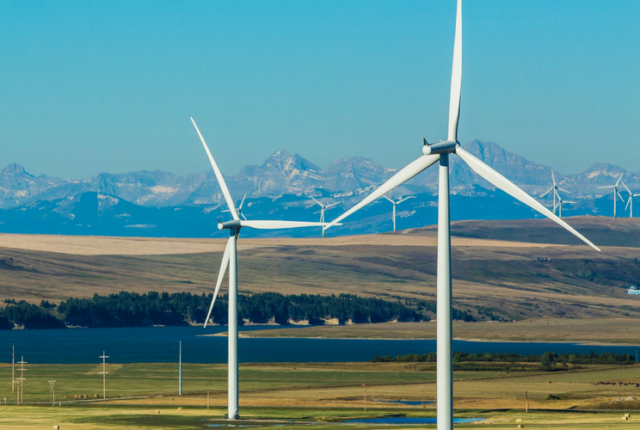A Maryland Jewish congregation recently prepared a guide to help members switch to 100% wind-generated electricity. The DC city council has taken a “preliminary vote” to require that 100% of Washington’s electricity come from renewable sources by 2032.
Starbucks Illinois says its 340 stores will run entirely on wind energy by 2020. Other companies and even entire states claim they will go totally “renewable” by 2030 or 2050.
They believe wind-based electricity is ecological, sustainable, humanitarian and climate-friendly. Their desires are heartfelt.
But are they remotely possible in the real world? Can modern societies function on 100% or even 50% or 20% unpredictably intermittent renewable energy? Is it really as clean and ethical as many claim?
Raw wind and solar energy are certainly renewable, ecological and sustainable. However, the technologies required to harness and utilize that energy are not.
A 1.7 megawatt (MW) wind turbine requires 1,100 tons of concrete and steel rebar for the foundation – plus some 370 tons of materials for the turbine assembly and tower: including 800 pounds of neodymium, 130 pounds of dysprosium, other rare earth elements, and tons of iron, copper, and petroleum composites.
Large-scale wind-based electricity would require thousands of turbines on millions of acres of crop, scenic and wildlife habitat land.
To ensure power during windless hours, days or weeks, coal- or gas-fired power plants must operate inefficiently on standby, ready to surge to full power many times daily. That means more fuel, metals and concrete. Ultra-long transmission lines from windy areas to urban centers require still more land and materials.
The principal alternative to backup power plants is huge rechargeable batteries. They require lithium, cadmium and other metals, also in enormous quantities.
None of these materials is renewable. And most come from problematical sources.
Baotou and other parts of China provide 95% of today’s rare earth elements, mined and processed under horrendous environmental and worker safety conditions. China engages in rampant technology theft and has sent over a million Uighur Muslims to detention camps.
More than half of all lithium is sourced from an area in central South America, also under substandard conditions.
Over 60% of the cobalt comes from the Democratic Republic of Congo. Much of it is extracted by hand, by parents and children, in pits and narrow tunnels, under constant risk of cave-ins, toxic chemical exposure and serious lung diseases.
Anyone concerned about pollution, child labor, fair trade, fair wages, sweat shops, worker safety and social justice should be appalled. They should demand that utility companies, wind turbine makers and battery manufacturers apply these standards – and prove their components are sourced responsibly.
Moreover, all these components require removing billions of tons of rock, processing and smelting millions of tons of ores into usable metals, refining crude oil into resins and composites, and manufacturing finished products. Every step requires fossil fuels.
Not even one wind turbine can yet be manufactured, transported, installed or maintained with wind energy.
That means extensive air and water pollution, and a huge “carbon footprint.” It may be thousands of miles away, but it is real – and it is accompanied by extensive environmental destruction.
Indeed, the impacts are likely worse than if we just relied on coal or gas generators, instead of relegating them to backup status or replacing them with batteries, in an attempt to “go renewable.”
Wind turbines also kill millions of eagles, hawks, other birds and bats. Light flicker, low-frequency noise and vibrations affect the sleep and health of people living near turbines.
Wind energy’s inadequacy is most pronounced during our hottest and coldest weather, when high pressure systems bring wind speeds down near zero. When brutal cold hit the Mid-Atlantic and its regional transmission system this past January, for example, total electricity usage reached 140,000 MW. Wind provided just 0.7% of that.
Without reliable coal, gas and nuclear power, people would have frozen in the dark.
Many believe plant-fertilizing carbon dioxide has replaced the sun and other powerful natural forces in causing climate change. Even if they are correct, even totally eliminating America’s fossil fuels will make no difference globally, because other countries are building thousands of coal and gas-fueled power plants.
Over 200,000 MW of coal-fired power are under construction in just eight Asian countries, and more projects are underway in Africa and Europe.
Additionally, the nation’s integrated grid constantly pools electricity from wind, solar, coal, gas, nuclear, hydro and other sources. There is no way to tell which electrons entering a home are from wind, unless it has a private transmission direct from a wind farm – and its residents are content to get electricity when it’s available, instead of when they need it.
They may get a certificate, saying their electricity is wind-generated – or an equivalent amount was generated somewhere from wind. But they are not likely to get 100% wind-generated electricity or know what source is actually generating their electricity at any given time.
The key for the grid and consumers remains the ability to transmit electricity when demanded, in the amounts required and at affordable prices.
Jews everywhere seek tikun olam (creation care) and social justice. But achieving these goals can be more complex and difficult than many realize. It too often devolves into perfunctory analysis and slick PR.
“Trust but verify” is still a good rule of thumb, including on renewable energy claims.
Paul Driessen is senior policy advisor for the Committee For A Constructive Tomorrow (www.CFACT.org) and author of articles and books on energy, environmental, human rights and corporate ethics issues. He is a member of Congregation Olam Tikvah in Virginia.






